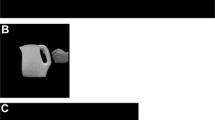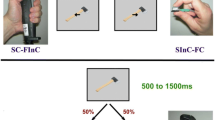Abstract
Seeing an object activates both visual and action codes in the brain. Crucial evidence supporting this view is the observation of object to response compatibility effects: perception of an object can facilitate or interfere with the execution of an action (e.g., grasping) even when the viewer has no intention of interacting with the object. TRoPICALS is a computational model that proposes some general principles about the brain mechanisms underlying compatibility effects, in particular the idea that top-down bias from prefrontal cortex, and whether it conflicts or not with the actions afforded by an object, plays a key role in such phenomena. Experiments on compatibility effects using a target and a distractor object show the usual positive compatibility effect of the target, but also an interesting negative compatibility effect of the distractor: responding with a grip compatible with the distractor size produces slower reaction times than the incompatible case. Here, we present an enhanced version of TRoPICALS that reproduces and explains these new results. This explanation is based on the idea that the prefrontal cortex plays a double role in its top-down guidance of action selection producing: (a) a positive bias in favour of the action requested by the experimental task; (b) a negative bias directed to inhibiting the action evoked by the distractor. The model also provides testable predictions on the possible consequences of damage to volitional circuits such as in Parkinsonian patients.




Similar content being viewed by others
References
Arbib, M. A. (1997). From visual affordances in monkey parietal cortex to hippocampo-parietal interactions underlying rat navigation. Philosophical Transactions of The Royal Society B Biological Sciences, 352, 1429–1436.
Barsalou, L. W. (2008). Grounded cognition. Annual Review of Psychology, 59, 617–645.
Behrmann, M., Geng, J. J., & Shomstein, S. (2004). Parietal cortex and attention. Current Opinion in Neurobiology, 14, 212–217.
Berthier, N. E., Rosenstein, M. T., & Barto, A. G. (2005). Approximate optimal control as a model for motor learning. Psychological Review, 112, 329–346.
Borghi, A. M., Di Ferdinando, A., & Parisi, D. (2011). Objects, spatial compatibility, and affordances: A connectionist study. Cognitive Systems Research, 12, 33–44.
Caligiore, D., Borghi, A. M., Parisi, D., & Baldassarre, G. (2010a). TRoPICALS: A computational embodied neuroscience model of compatibility effects. Psychological Review, 117, 1188–1228.
Caligiore, D., Borghi, A.M., Parisi, D., Ellis, R., Cangelosi, A., & Baldassarre, G. (2011). Affordances of distractors and compatibility effects: A study with the computational model TRoPICALS. Available from Nature Precedings (http://dx.doi.org/10.1038/npre.2011.5848.1).
Caligiore, D., Ferrauto, T., Parisi, D., Accornero, N., Capozza, M., & Baldassare, G. (2008). Using motor babbling and Hebb rules for modeling the development of reaching with obstacles and grasping. In R. Dillmann, C. Maloney, G. Sandini, T. Asfour, G. Cheng, G. Metta, & A. Ude (Eds.), International Conference on Cognitive Systems (pp. E1–E8). Karlsruhe: University of Karlsruhe.
Caligiore, D., Guglielmelli, E., Borghi, A. M., Parisi, D., & Baldassarre, G. (2010b). A Reinforcement Learning Model of Reaching Integrating Kinematic and Dynamic Control in a Simulated Arm Robot. In: IEEE International Conference on Development and Learning (ICDL2010), IEEE, Piscataway, NJ, pp 211–218.
Cisek, P. (2007). Cortical mechanisms of action selection: The affordance competition hypothesis. Philosophical Transactions of The Royal Society B-Biological Sciences, 362, 1585–1599.
Cisek, P., & Kalaska, J. F. (2005). Neural correlates of reaching decisions in dorsal premotor cortex: Specification of multiple direction choices and final selection of action. Neuron, 45, 801–814.
Clark, A. (1996). Being there–Putting brain, body and world together again. Cambridge: MIT Press.
Culham, J. C., & Kanwisher, N. G. (2001). Neuroimaging of cognitive functions in human parietal cortex. Current Opinion in Neurobiology, 11, 157–163.
Dayan, P., & Abbott, L. F. (2001). Theoretical neuroscience: Computational and mathematical modeling of neural systems. Cambridge: MIT Press.
Deco, G., & Rolls, E. T. (2003). Attention and working memory: A dynamical model of neuronal activity in the prefrontal cortex. European Journal of Neuroscience, 18, 2374–2390.
Ehrsson, H. H., Fagergren, A., Jonsson, T., Westling, G., Johansson, R. S., & Forssberg, H. (2000). Cortical activity in precision–versus power-grip tasks: An fMRI study. Journal of Neurophysiology, 83, 528–536.
Ellis, R., Tucker, M., Symes, E., & Vainio, L. (2007). Does selecting one visual object from several require inhibition of the actions associated with non selected objects? Journal of Experimental Psychology: Human Perception and Performance, 33, 670–691.
Erlhagen, W., & Schöner, G. (2002). Dynamic field theory of movement preparation. Psychological Review, 109, 545–572.
Fagg, A. H., & Arbib, M. A. (1998). Modeling parietal-premotor interaction in primate control of grasping. Neural Networks, 11, 1277–1303.
Feldman, A. G. (1986). Once more on the equilibrium-point hypothesis (lambda model) for motor control. Journal of Motor Behavior, 18, 17–54.
Fuster, J. M. (1997). The prefrontal cortex: Anatomy, physiology, and neuropsychology of the frontal lobe. Philadelphia: Lippincott-Raven.
Fuster, J. M. (2001). The prefrontal cortex–an update: Time is of the essence. Neuron, 30, 319–333.
Galpin, A., Tipper, S. P., Dick, J. P., & Poliakoff, E. (2010). Object affordance and spatial-compatibility effects in Parkinson’s disease. Cortex, 47, 332–341.
Gibson, J. J. (1979). The ecological approach to visual perception. Boston: Houghton Mifflin.
Grèzes, J., Tucker, M., Armony, J., Ellis, R., & Passingham, R. E. (2003). Objects automatically potentiate action: An fMRI study of implicit processing. European Journal of Neuroscience, 17, 2735–2740.
Grill-Spector, K. (2008). Object perception: Physiology. In B. Goldstein (Ed.), Encyclopedia of perception (pp. 648–653). Sage Publications.
Grill-Spector, K., & Malach, R. (2004). The human visual cortex. Annual Review of Neuroscience, 27, 649–677.
Haggard, P. (2008). Human volition: Towards a neuroscience of will. Nature Reviews Neuroscience, 9, 934–946.
Hubel, D. H. (1988). Eye, brain and vision. Scientific American Books: New York.
Iberall, T., & Arbib, M. A. (1990). Schemas for the control of hand movements: An essay on cortical localization. In M. A. Goodale (Ed.), Vision and action: The control of grasping (pp. 163–180). Norwood: Ablex Publishing.
Jahanshahi, M., Jenkins, H., Brown, R. G., Marsden, C. D., Passingham, R. E., & Brooks, D. J. (1995). Self-initiated versus externally triggered movements. I. An investigation using measurement of regional cerebral blood flow with pet and movement-related potentials in normal and Parkinson’s disease subjects. Brain, 118, 913–933.
Jeannerod, M. (1994). The representing brain: Neural correlates of motor intention and imagery. Behavioral and Brain Sciences, 17, 187–246.
Kandel, E. R., Schwartz, J. H., & Jessel, T. M. (2000). Principles of Neural Science. New York: McGraw-Hill.
Knight, R. T., Staines, W. R., Swickc, D., & Chaoc, L. L. (1999). Prefrontal cortex regulates inhibition and excitation in distributed neural networks. Acta Psychologica, 101, 159–178.
Kohonen, T. (1997). Self-Organizing Maps (Second Edition ed.). Berlin: Springer-Verlag.
Lang, A., & Lozano, A. (1998). Parkinson’s disease. New England Journal of Medicine, 339, 1044–1053.
Lisman, J. (1989). A mechanism for the Hebb and the anti-Hebb processes underlying learning and memory. Proceedings of the National Academy of Sciences of the United States of America, 86(23), 9574–9578.
Logothetis, N. K., Pauls, J., & Poggio, T. (1995). Shape representation in the inferior temporal cortex of monkeys. Current Biology, 5, 552–563.
Miller, E. K., & Cohen, J. D. (2001). An integrative theory of premotor cortex function. Annual Review of Neuroscience, 24, 167–202.
Milner, D. A., & Goodale, M. A. (1995). The Visual Brain in Action. Oxford: Oxford University Press.
Murata, A., Gallese, V., Luppino, G., Kaseda, M., & Sakata, H. (2000). Selectivity for the shape, size, and orientation of objects for grasping in neurons of monkey parietal area AIP. Journal of Neurophysiology, 83, 2580–2601.
Nachev, P., Kennard, C., & Husain, M. (2008). Functional role of the supplementary and pre-supplementary motor areas. Nature Reviews Neuroscience, 9, 856–869.
Noë, A. (2004). Action in perception. In H. Putnam & N. Block (Eds.), Perception (Vol. 37). MIT Press.
Nolfi, S. (2009). Behavior and cognition as a complex adaptive system: Insights from robotic experiments. In C. Hooker (Ed.), Handbook of the Philosophy of Science. Volume 10: Philosophy of Complex Systems. General editors: Dov M. Gabbay, Paul Thagard and John Woods. Elsevier.
Oguro, H., Ward, R., Bracewel, M., Hindle, J., & Rafal, R. (2009). Automatic activation of motor programs by object affordances in patients with Parkinson’s disease. Neuroscience Letters, 9, 856–869.
Oztop, E., Bradley, N. S., & Arbib, M. A. (2004). Infant grasp learning: A computational model. Experimental Brain Research, 158, 480–503.
Parisi, D., Ceccon, F., & Nolfi, S. (1990). Econets: Neural networks that learn in an environment. Network, 1, 149–168.
Plunkett, K., & Elman, J. L. (1997). Exercises in rethinking innateness: A handbook for connectionist simulations. Cambridge: The MIT Press.
Pouget, A., Dayan, P., & Zemel, R. (2000). Information processing and population codes. Nature Reviews Neuroscience, 1, 125–132.
Redgrave, P., Prescott, T. J., & Gurney, K. (1999). The basal ganglia: A vertebrate solution to the selection problem? Neuroscience, 89, 1009–1023.
Redgrave, P., Rodriguez, M., Smith, Y., Rodriguez-Oroz, M. C., Lehericy, S., Bergman, H., et al. (2010). Goal-directed and habitual control in the basal ganglia: Implications for Parkinson’s disease. Nature Reviews Neuroscience, 11, 760–772.
Rizzolatti, G., & Craighero, L. (2004). The mirror neuron system. Annual Review of Neuroscience, 27, 169–192.
Rizzolatti, G., Fogassi, L., & Gallese, V. (1997). Parietal cortex: From sight to action. Current Opinion in Neurobiology, 7, 562–567.
Rizzolatti, G., Luppino, G., & Matelli, M. (1998). The organization of the cortical motor system: New concepts. Electroencephalography and Clinical Neurophysiology/Electromyography and Motor Control, 106, 283–296.
Simon, O., Mangin, J. F., Cohen, L., Bihan, D. L., & Dehaene, S. (2002). Topographical layout of hand, eye, calculation, and language-related areas in the human parietal lobe. Neuron, 33, 475–487.
Sobel, I., & Feldman, G. (1968). A 3x3 isotropic gradient operator for image processing, Presentation for Stanford Artificial Project.
Sternberg, S. (1969). The discovery of processing stages: Extensions of Doder’s method. In W. G. Koster (Ed.), Attention and Performance II. Amsterdam: North-Holland Publishing Company.
Tucker, M., & Ellis, R. (2001). The potentiation of grasp types during visual object categorization. Visual Cognition, 8, 769–800.
Tucker, M., & Ellis, R. (2004). Action priming by briefly presented objects. Acta Psychologica, 116, 185–203.
Ungerleider, L. G., & Mishkin, M. (1982). Two cortical visual systems. In D. J. Ingle, M. A. Goodale, & R. J. W. Mansfield (Eds.), Analysis of visual behavior (pp. 549–586). Cambridge: MIT Press.
Van Essen, D. C., Lewis, J. W., Drury, H. A., Hadjikhani, N., Tootell, R. B., Bakircioglu, M., et al. (2001). Mapping visual cortex in monkeys and humans using surface-based atlases. Vision Research, 41, 1359–1378.
Vinberg, J., & Grill-Spector, K. (2008). Representation of shapes, edges, and surfaces across multiple cues in the human visual cortex. Journal of Neurophysiology, 99, 1380–1393.
Weiner, K. S., Grill-Spector (2012) Neural representations of faces and limbs neighbor in human high-level visual cortex: Evidence for a new organization principle (accepted to this special issue).
Acknowledgments
This research was supported by the EU funded Projects “ROSSI–Emergence of communication in RObots through Sensorimotor and Social Interaction”, contract no. FP7-STREP-216125, “IM-CLeVeR–Intrinsically Motivated Cumulative Learning Versatile Robots”, contract no. FP7-IP -231722, “iTalk–Integration and Transfer of Action and Language Knowledge in Robots”, contract no. FP7-ICT-214668, and “VALUE–Vision, Action, and Language Unified by Embodiment”, EPSRC Grant EP/F026471. We thank Prof. Roberto Bolzani for helping in statistical data analysis.
Author information
Authors and Affiliations
Corresponding author
Rights and permissions
About this article
Cite this article
Caligiore, D., Borghi, A.M., Parisi, D. et al. How affordances associated with a distractor object affect compatibility effects: A study with the computational model TRoPICALS. Psychological Research 77, 7–19 (2013). https://doi.org/10.1007/s00426-012-0424-1
Received:
Accepted:
Published:
Issue Date:
DOI: https://doi.org/10.1007/s00426-012-0424-1




